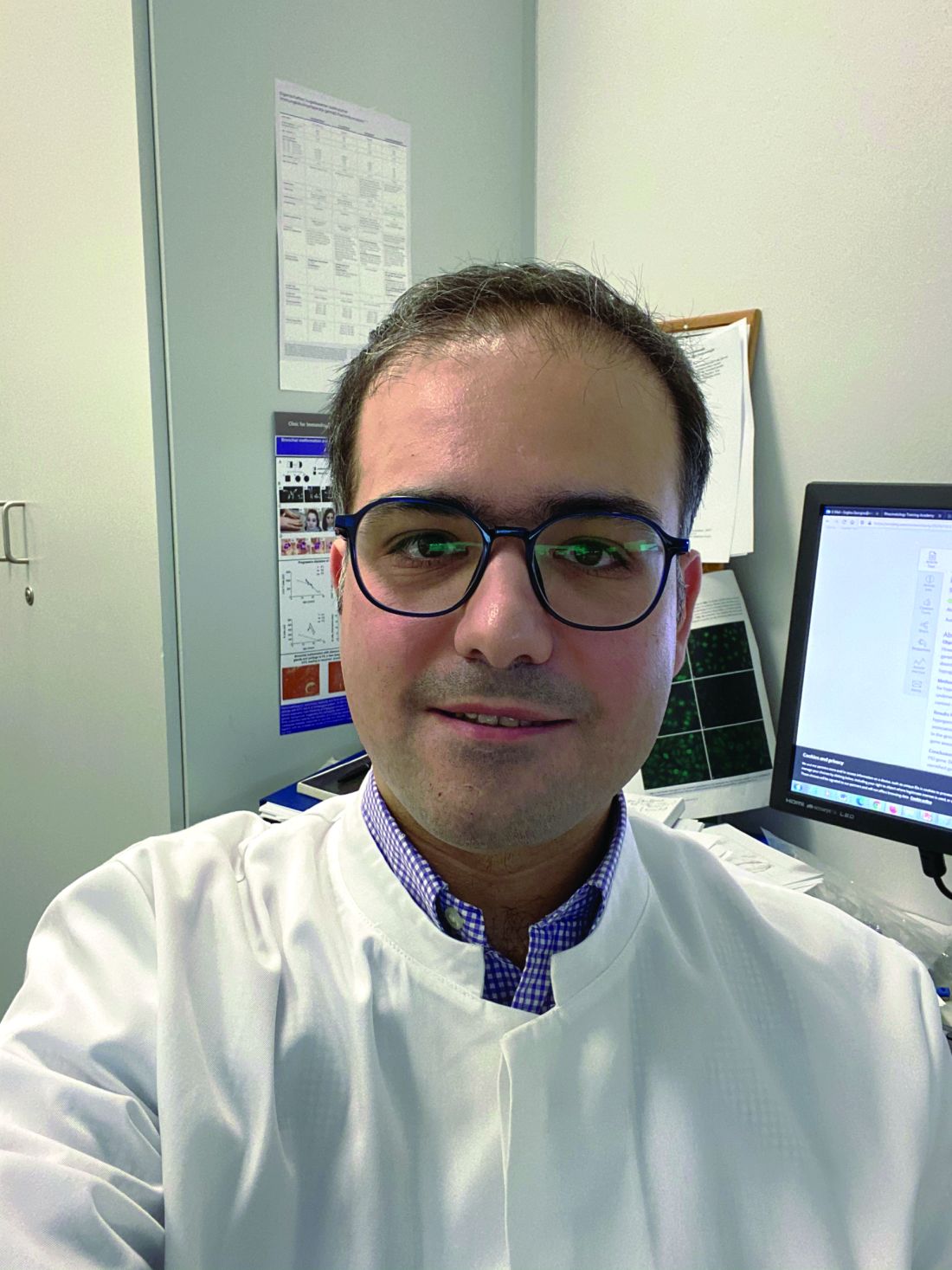User login
Fully 48% of patients with autoimmune rheumatic diseases who developed persistent hypogammaglobulinemia after initiating treatment with immunomodulatory agents harbored gene variants associated with inborn errors of immunity, according to the findings of a single-center study published in Annals of the Rheumatic Diseases.
The results raise the possibility of a shared genetic etiology between “primary” and “secondary” hypogammaglobulinemia and suggest that some cases of autoimmune rheumatic disease may result from inborn errors of immunity. “In other words, a rheumatologist may be treating the rheumatic manifestations of a primary immunodeficiency disorder,” the study’s lead author, Georgios Sogkas, MD, PhD, said in an interview.
Experts now widely acknowledge an association between rheumatic diseases and inborn errors of immunity, or primary immunodeficiencies (PIDs). In one recent large retrospective study, 26% of patients with PIDs had at least one autoimmune or inflammatory disorder, and at least 13% of patients with PIDs had autoimmune rheumatic diseases. However, few studies have sought explanations for this link.
Only a minority of patients develop persistent hypogammaglobulinemia in response to immunomodulatory treatments for rheumatic diseases, suggesting a genetic basis for this outcome, according to Dr. Sogkas of the clinic for rheumatology and immunology at Hannover (Germany) Medical University. To explore this possibility, he and his associates measured the serum IgG levels of 1,008 Hannover University Hospital outpatients with autoimmune rheumatic diseases. In all, 64 patients had “persistent secondary hypogammaglobulinemia,” defined as at least a 12-month history of having serum IgG levels less than 7 g/L that began after the patients started on prednisolone or one or more synthetic or biologic disease-modifying antirheumatic drugs (DMARDs). Using next-generation sequencing (NGS), the researchers screened for known or candidate genes associated with primary antibody deficiencies by testing peripheral blood samples from this cohort and from 64 randomly selected patients with rheumatic diseases who did not have persistent hypogammaglobulinemia.
Among the patients with hypogammaglobulinemia, 31 (48%) had one or more potentially pathogenic variants (35 variants in total, all of them monoallelic). Notably, 10 patients (nearly 16%) harbored variants linked to autosomal dominant PIDs, and five patients harbored variants in NFKB1, which encodes the p51 subunit of the associated transcription factor. Among the 64 patients without hypogammaglobulinemia, only 7 (11%) harbored variants in the same PID-related genes, and only 1 had an autosomal dominant variant. This patient, who had a history of recurrent herpes infections, harbored a variant in the IRF2BP2 gene that does not necessarily lead to hypogammaglobulinemia, the researchers said.
‘Striking’ findings suggest a future in personalized medicine
Experts who were not involved in the study called the results noteworthy. “The fact that half of patients with rheumatic disease who developed secondary hypogammaglobulinemia were found to have a functionally relevant mutation in a known PID gene is striking, albeit purely circumstantial given the absence of any functional or mechanistic data,” said Michael J. Ombrello, MD, principal investigator and head of the translational genetics and genomics unit at the National Institute of Arthritis and Musculoskeletal and Skin Diseases, who was not involved in the study.
The findings, if they are validated by additional studies, might help clinicians personalize medicine by avoiding hypogammaglobulinemia-inducing immunomodulatory regimens in genetically predisposed patients, or by targeting Janus kinase (JAK) inhibitor therapy for patients with STAT3 gain-of-function variants, or PI3K delta inhibitors for patients with variants leading to hyperactivation of the PI3Kdelta gene, Dr. Sogkas said.
Dr. Ombrello agreed: “Whether the hypogammaglobulinemia is classified as primary or secondary, the presence of these genetic variants in half of patients with hypogammaglobulinemia suggests an opportunity to improve clinical care. Although far off at this point, one can imagine a day where genetic data allows a rheumatologist to identify new-onset rheumatic disease patients carrying PID gene mutations and cater their therapy and monitoring accordingly.”
If further research validates these findings, they would add to a growing body of support for incorporating expanded or universal exome or genome sequencing in the care of medically complex patients, such as those with rheumatic diseases, Dr. Ombrello said. However, he cautioned that the investigators could have “overstated” the relationship in their study between secondary hypogammaglobulinemia and immunomodulatory treatment. The fact that a small group of study participants (about 7%) developed hypogammaglobulinemia after initiating immunomodulatory therapy does not confirm a causal relationship, he emphasized. Common variable immune deficiency (CVID) can develop in adults as late as the fifth and sixth decade of life, he noted, making it “not implausible that a small number of rheumatic disease patients would develop CVID while under the care of a rheumatologist. Would these patients have developed hypogammaglobulinemia even without treatment with immunomodulators, purely related to their genetic mutations? If so, they would be better classified as having primary immune deficiency, although that distinction is largely one of semantics.”
‘Rheumatologists are obliged to step up’
Interestingly, only 23% of the patients with hypogammaglobulinemia in the study had a clinically significant history of infections even though only 9% were receiving prophylactic antibiotics. Such findings highlight the complexity of PIDs, according to experts. “A long generation ago, we thought of immunodeficiencies as infections. Now we see them as autoimmune diseases, inflammatory diseases, allergic diseases – the spectrum continues to enlarge,” said Leonard H. Calabrese, DO, the RJ Fasenmyer chair of clinical immunology at the Cleveland Clinic, who was not involved in the study.
Dr. Calabrese noted that more than 450 monogenic variants have been linked to inborn errors of immunity. “Because these [PIDs] can mimic autoinflammatory presentations, rheumatologists are obliged to step up and gain a greater understanding, to be able to recognize and diagnose them and sort them out.”
Future goals should include quantifying the prevalence of genetic variants underlying hypogammaglobulinemia among patients with rheumatic diseases, and better characterizing outcomes and phenotypes of patients harboring variants linked to inborn errors of immunity, Dr. Sogkas said. “Whether these patients actually have a different disease than what they are being treated for, I can’t tell from this paper, and that’s an important question for the future,” added Dr. Calabrese. “I also do wonder about the effects of different drugs,” he said, noting that many patients with PID-associated autosomal gene variants developed persistent secondary hypogammaglobulinemia after initiating methotrexate. “It makes me wonder whether some of these genes have a specific interaction with methotrexate,” he said. “That could be a biomarker for drug toxicity.”
Study funders included the German Research Foundation, the German multiorgan Autoimmunity Network, Hannover Medical School, the Rosemarie-Germscheid Foundation, the German Academic Exchange Service, HBRS, the Center for Infection Biology, and the German Center for Infection Research. The investigators reported having no competing interests.
SOURCE: Sogkas G et al. Ann Rheum Dis. 2020 Oct 12. doi: 10.1136/annrheumdis-2020-218280.
Fully 48% of patients with autoimmune rheumatic diseases who developed persistent hypogammaglobulinemia after initiating treatment with immunomodulatory agents harbored gene variants associated with inborn errors of immunity, according to the findings of a single-center study published in Annals of the Rheumatic Diseases.
The results raise the possibility of a shared genetic etiology between “primary” and “secondary” hypogammaglobulinemia and suggest that some cases of autoimmune rheumatic disease may result from inborn errors of immunity. “In other words, a rheumatologist may be treating the rheumatic manifestations of a primary immunodeficiency disorder,” the study’s lead author, Georgios Sogkas, MD, PhD, said in an interview.
Experts now widely acknowledge an association between rheumatic diseases and inborn errors of immunity, or primary immunodeficiencies (PIDs). In one recent large retrospective study, 26% of patients with PIDs had at least one autoimmune or inflammatory disorder, and at least 13% of patients with PIDs had autoimmune rheumatic diseases. However, few studies have sought explanations for this link.
Only a minority of patients develop persistent hypogammaglobulinemia in response to immunomodulatory treatments for rheumatic diseases, suggesting a genetic basis for this outcome, according to Dr. Sogkas of the clinic for rheumatology and immunology at Hannover (Germany) Medical University. To explore this possibility, he and his associates measured the serum IgG levels of 1,008 Hannover University Hospital outpatients with autoimmune rheumatic diseases. In all, 64 patients had “persistent secondary hypogammaglobulinemia,” defined as at least a 12-month history of having serum IgG levels less than 7 g/L that began after the patients started on prednisolone or one or more synthetic or biologic disease-modifying antirheumatic drugs (DMARDs). Using next-generation sequencing (NGS), the researchers screened for known or candidate genes associated with primary antibody deficiencies by testing peripheral blood samples from this cohort and from 64 randomly selected patients with rheumatic diseases who did not have persistent hypogammaglobulinemia.
Among the patients with hypogammaglobulinemia, 31 (48%) had one or more potentially pathogenic variants (35 variants in total, all of them monoallelic). Notably, 10 patients (nearly 16%) harbored variants linked to autosomal dominant PIDs, and five patients harbored variants in NFKB1, which encodes the p51 subunit of the associated transcription factor. Among the 64 patients without hypogammaglobulinemia, only 7 (11%) harbored variants in the same PID-related genes, and only 1 had an autosomal dominant variant. This patient, who had a history of recurrent herpes infections, harbored a variant in the IRF2BP2 gene that does not necessarily lead to hypogammaglobulinemia, the researchers said.
‘Striking’ findings suggest a future in personalized medicine
Experts who were not involved in the study called the results noteworthy. “The fact that half of patients with rheumatic disease who developed secondary hypogammaglobulinemia were found to have a functionally relevant mutation in a known PID gene is striking, albeit purely circumstantial given the absence of any functional or mechanistic data,” said Michael J. Ombrello, MD, principal investigator and head of the translational genetics and genomics unit at the National Institute of Arthritis and Musculoskeletal and Skin Diseases, who was not involved in the study.
The findings, if they are validated by additional studies, might help clinicians personalize medicine by avoiding hypogammaglobulinemia-inducing immunomodulatory regimens in genetically predisposed patients, or by targeting Janus kinase (JAK) inhibitor therapy for patients with STAT3 gain-of-function variants, or PI3K delta inhibitors for patients with variants leading to hyperactivation of the PI3Kdelta gene, Dr. Sogkas said.
Dr. Ombrello agreed: “Whether the hypogammaglobulinemia is classified as primary or secondary, the presence of these genetic variants in half of patients with hypogammaglobulinemia suggests an opportunity to improve clinical care. Although far off at this point, one can imagine a day where genetic data allows a rheumatologist to identify new-onset rheumatic disease patients carrying PID gene mutations and cater their therapy and monitoring accordingly.”
If further research validates these findings, they would add to a growing body of support for incorporating expanded or universal exome or genome sequencing in the care of medically complex patients, such as those with rheumatic diseases, Dr. Ombrello said. However, he cautioned that the investigators could have “overstated” the relationship in their study between secondary hypogammaglobulinemia and immunomodulatory treatment. The fact that a small group of study participants (about 7%) developed hypogammaglobulinemia after initiating immunomodulatory therapy does not confirm a causal relationship, he emphasized. Common variable immune deficiency (CVID) can develop in adults as late as the fifth and sixth decade of life, he noted, making it “not implausible that a small number of rheumatic disease patients would develop CVID while under the care of a rheumatologist. Would these patients have developed hypogammaglobulinemia even without treatment with immunomodulators, purely related to their genetic mutations? If so, they would be better classified as having primary immune deficiency, although that distinction is largely one of semantics.”
‘Rheumatologists are obliged to step up’
Interestingly, only 23% of the patients with hypogammaglobulinemia in the study had a clinically significant history of infections even though only 9% were receiving prophylactic antibiotics. Such findings highlight the complexity of PIDs, according to experts. “A long generation ago, we thought of immunodeficiencies as infections. Now we see them as autoimmune diseases, inflammatory diseases, allergic diseases – the spectrum continues to enlarge,” said Leonard H. Calabrese, DO, the RJ Fasenmyer chair of clinical immunology at the Cleveland Clinic, who was not involved in the study.
Dr. Calabrese noted that more than 450 monogenic variants have been linked to inborn errors of immunity. “Because these [PIDs] can mimic autoinflammatory presentations, rheumatologists are obliged to step up and gain a greater understanding, to be able to recognize and diagnose them and sort them out.”
Future goals should include quantifying the prevalence of genetic variants underlying hypogammaglobulinemia among patients with rheumatic diseases, and better characterizing outcomes and phenotypes of patients harboring variants linked to inborn errors of immunity, Dr. Sogkas said. “Whether these patients actually have a different disease than what they are being treated for, I can’t tell from this paper, and that’s an important question for the future,” added Dr. Calabrese. “I also do wonder about the effects of different drugs,” he said, noting that many patients with PID-associated autosomal gene variants developed persistent secondary hypogammaglobulinemia after initiating methotrexate. “It makes me wonder whether some of these genes have a specific interaction with methotrexate,” he said. “That could be a biomarker for drug toxicity.”
Study funders included the German Research Foundation, the German multiorgan Autoimmunity Network, Hannover Medical School, the Rosemarie-Germscheid Foundation, the German Academic Exchange Service, HBRS, the Center for Infection Biology, and the German Center for Infection Research. The investigators reported having no competing interests.
SOURCE: Sogkas G et al. Ann Rheum Dis. 2020 Oct 12. doi: 10.1136/annrheumdis-2020-218280.
Fully 48% of patients with autoimmune rheumatic diseases who developed persistent hypogammaglobulinemia after initiating treatment with immunomodulatory agents harbored gene variants associated with inborn errors of immunity, according to the findings of a single-center study published in Annals of the Rheumatic Diseases.
The results raise the possibility of a shared genetic etiology between “primary” and “secondary” hypogammaglobulinemia and suggest that some cases of autoimmune rheumatic disease may result from inborn errors of immunity. “In other words, a rheumatologist may be treating the rheumatic manifestations of a primary immunodeficiency disorder,” the study’s lead author, Georgios Sogkas, MD, PhD, said in an interview.
Experts now widely acknowledge an association between rheumatic diseases and inborn errors of immunity, or primary immunodeficiencies (PIDs). In one recent large retrospective study, 26% of patients with PIDs had at least one autoimmune or inflammatory disorder, and at least 13% of patients with PIDs had autoimmune rheumatic diseases. However, few studies have sought explanations for this link.
Only a minority of patients develop persistent hypogammaglobulinemia in response to immunomodulatory treatments for rheumatic diseases, suggesting a genetic basis for this outcome, according to Dr. Sogkas of the clinic for rheumatology and immunology at Hannover (Germany) Medical University. To explore this possibility, he and his associates measured the serum IgG levels of 1,008 Hannover University Hospital outpatients with autoimmune rheumatic diseases. In all, 64 patients had “persistent secondary hypogammaglobulinemia,” defined as at least a 12-month history of having serum IgG levels less than 7 g/L that began after the patients started on prednisolone or one or more synthetic or biologic disease-modifying antirheumatic drugs (DMARDs). Using next-generation sequencing (NGS), the researchers screened for known or candidate genes associated with primary antibody deficiencies by testing peripheral blood samples from this cohort and from 64 randomly selected patients with rheumatic diseases who did not have persistent hypogammaglobulinemia.
Among the patients with hypogammaglobulinemia, 31 (48%) had one or more potentially pathogenic variants (35 variants in total, all of them monoallelic). Notably, 10 patients (nearly 16%) harbored variants linked to autosomal dominant PIDs, and five patients harbored variants in NFKB1, which encodes the p51 subunit of the associated transcription factor. Among the 64 patients without hypogammaglobulinemia, only 7 (11%) harbored variants in the same PID-related genes, and only 1 had an autosomal dominant variant. This patient, who had a history of recurrent herpes infections, harbored a variant in the IRF2BP2 gene that does not necessarily lead to hypogammaglobulinemia, the researchers said.
‘Striking’ findings suggest a future in personalized medicine
Experts who were not involved in the study called the results noteworthy. “The fact that half of patients with rheumatic disease who developed secondary hypogammaglobulinemia were found to have a functionally relevant mutation in a known PID gene is striking, albeit purely circumstantial given the absence of any functional or mechanistic data,” said Michael J. Ombrello, MD, principal investigator and head of the translational genetics and genomics unit at the National Institute of Arthritis and Musculoskeletal and Skin Diseases, who was not involved in the study.
The findings, if they are validated by additional studies, might help clinicians personalize medicine by avoiding hypogammaglobulinemia-inducing immunomodulatory regimens in genetically predisposed patients, or by targeting Janus kinase (JAK) inhibitor therapy for patients with STAT3 gain-of-function variants, or PI3K delta inhibitors for patients with variants leading to hyperactivation of the PI3Kdelta gene, Dr. Sogkas said.
Dr. Ombrello agreed: “Whether the hypogammaglobulinemia is classified as primary or secondary, the presence of these genetic variants in half of patients with hypogammaglobulinemia suggests an opportunity to improve clinical care. Although far off at this point, one can imagine a day where genetic data allows a rheumatologist to identify new-onset rheumatic disease patients carrying PID gene mutations and cater their therapy and monitoring accordingly.”
If further research validates these findings, they would add to a growing body of support for incorporating expanded or universal exome or genome sequencing in the care of medically complex patients, such as those with rheumatic diseases, Dr. Ombrello said. However, he cautioned that the investigators could have “overstated” the relationship in their study between secondary hypogammaglobulinemia and immunomodulatory treatment. The fact that a small group of study participants (about 7%) developed hypogammaglobulinemia after initiating immunomodulatory therapy does not confirm a causal relationship, he emphasized. Common variable immune deficiency (CVID) can develop in adults as late as the fifth and sixth decade of life, he noted, making it “not implausible that a small number of rheumatic disease patients would develop CVID while under the care of a rheumatologist. Would these patients have developed hypogammaglobulinemia even without treatment with immunomodulators, purely related to their genetic mutations? If so, they would be better classified as having primary immune deficiency, although that distinction is largely one of semantics.”
‘Rheumatologists are obliged to step up’
Interestingly, only 23% of the patients with hypogammaglobulinemia in the study had a clinically significant history of infections even though only 9% were receiving prophylactic antibiotics. Such findings highlight the complexity of PIDs, according to experts. “A long generation ago, we thought of immunodeficiencies as infections. Now we see them as autoimmune diseases, inflammatory diseases, allergic diseases – the spectrum continues to enlarge,” said Leonard H. Calabrese, DO, the RJ Fasenmyer chair of clinical immunology at the Cleveland Clinic, who was not involved in the study.
Dr. Calabrese noted that more than 450 monogenic variants have been linked to inborn errors of immunity. “Because these [PIDs] can mimic autoinflammatory presentations, rheumatologists are obliged to step up and gain a greater understanding, to be able to recognize and diagnose them and sort them out.”
Future goals should include quantifying the prevalence of genetic variants underlying hypogammaglobulinemia among patients with rheumatic diseases, and better characterizing outcomes and phenotypes of patients harboring variants linked to inborn errors of immunity, Dr. Sogkas said. “Whether these patients actually have a different disease than what they are being treated for, I can’t tell from this paper, and that’s an important question for the future,” added Dr. Calabrese. “I also do wonder about the effects of different drugs,” he said, noting that many patients with PID-associated autosomal gene variants developed persistent secondary hypogammaglobulinemia after initiating methotrexate. “It makes me wonder whether some of these genes have a specific interaction with methotrexate,” he said. “That could be a biomarker for drug toxicity.”
Study funders included the German Research Foundation, the German multiorgan Autoimmunity Network, Hannover Medical School, the Rosemarie-Germscheid Foundation, the German Academic Exchange Service, HBRS, the Center for Infection Biology, and the German Center for Infection Research. The investigators reported having no competing interests.
SOURCE: Sogkas G et al. Ann Rheum Dis. 2020 Oct 12. doi: 10.1136/annrheumdis-2020-218280.
FROM ANNALS OF THE RHEUMATIC DISEASES



